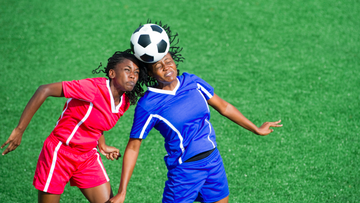*This article is part of an educational series for soccer parents and players new to soccer*
Concussions in Soccer
We don’t often think of soccer as a high-risk sport. Young children and older people enjoy playing soccer, and for most players, all they need is a pair of shoes, a net, and a ball to play the game. Yet new studies show that concussion rates in soccer are as high as many other contact sports. And did you know that 22% of all soccer injuries are concussions?
It may be time to reconsider protective equipment for all soccer players, including goalkeepers.
Risk of Concussion for Goalkeepers
Goalkeepers tend to stay away from heading the ball, but the frequent jumps, dives, and interactions with other players make them especially vulnerable to head injuries.
Soccer goalkeepers are also at risk for:
- Hard and fast close-distance shots directed right at them.
- Risk of getting kicked in the head when diving for a loose ball or blocking a shot.
Professional Goalkeepers Who Have Suffered Head Injuries
Concussions and head injuries are not just concerns for younger players. There are many examples of professional goalkeepers who have been injured during a game or practice. For most, the injury affected their ability to play over the long term. Here are just a few of the players who have suffered head trauma:
Petr Cech
Petr Cech, the goalkeeper for the champion team Chelsea, was horribly injured in a collision with a midfielder, Stephen Hunt. The collision happened during a match with Reading in 2006 at only 15 seconds into the game. Petr fractured his skull on Hunt’s knee or possibly his shin. He needed emergency brain surgery to save his life. Since his injury, Cech has worn a protective head guard for every game and practice.
Loris Karius
Loris Karius collided with a player during a game and then continued to play, but his injury has been blamed for several mistakes he made later in the game. Doctors say he suffered from "visual-spatial dysfunction,” a process that hampers a person's ability to process visual information about where objects are in space.
Doctor’s also explained that symptoms of a concussion can take hours or even days to appear. The damage is done deep in their brains, and delicate nerve fibers get damaged. These fibers come from the eyes and spread to the brain. Some people with concussions have very subtle visual symptoms or double vision.
It is easy to miss signs of concussion, so doctors say it is essential to remove athletes from play if there is even a slight concern for a concussion. This caution is to avoid further damage.
Fran Kitching
Fran Kitching, the goalkeeper for Liverpool Women, shared some shocking images of her head injuries after a training incident. She was injured while trying to gather a loose ball on the floor in training last week. This incident shows that brain injuries and concussions can occur at any time - during a game or practice.
How To Protect Yourself
Soccer goalie headgear can be effective in reducing the risk of certain types of head injuries. Soccer goalie helmets cannot protect against all head concussions or limit rotational forces that can cause damage. Still, new technology such as the Storelli ExoShield Head Guard can reduce impact to the head by an estimated 84%. It is also comfortable to wear for younger and older players.
The Storelli ExoShield Head Guard embeds the same type of foam used in US military helmets into its sleek design. It is also the Official Head Protection of the US Club Soccer and was awarded top five star rank from Virginia Tech’s Helmet Lab.
For young goaltenders, protecting their brains from long-term injury is essential. With more pro players understanding the importance of preventing concussions and wearing protective equipment, we will likely see more gear like this on the pitch in the future.

